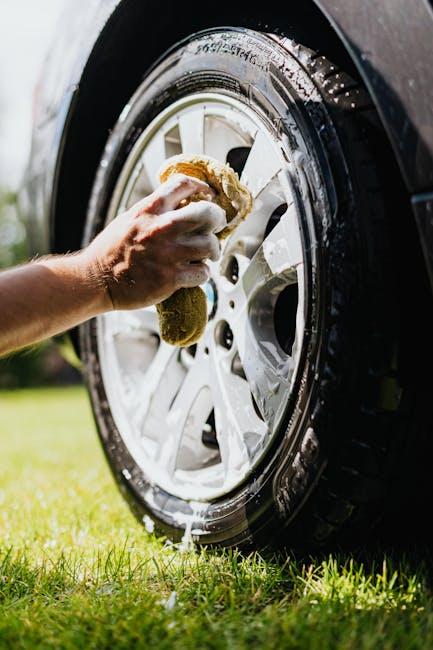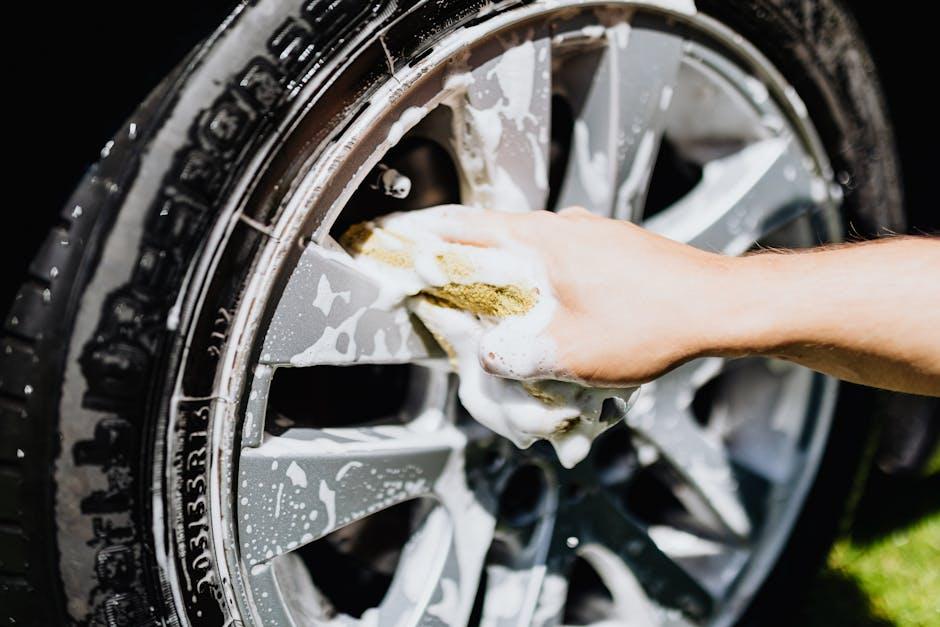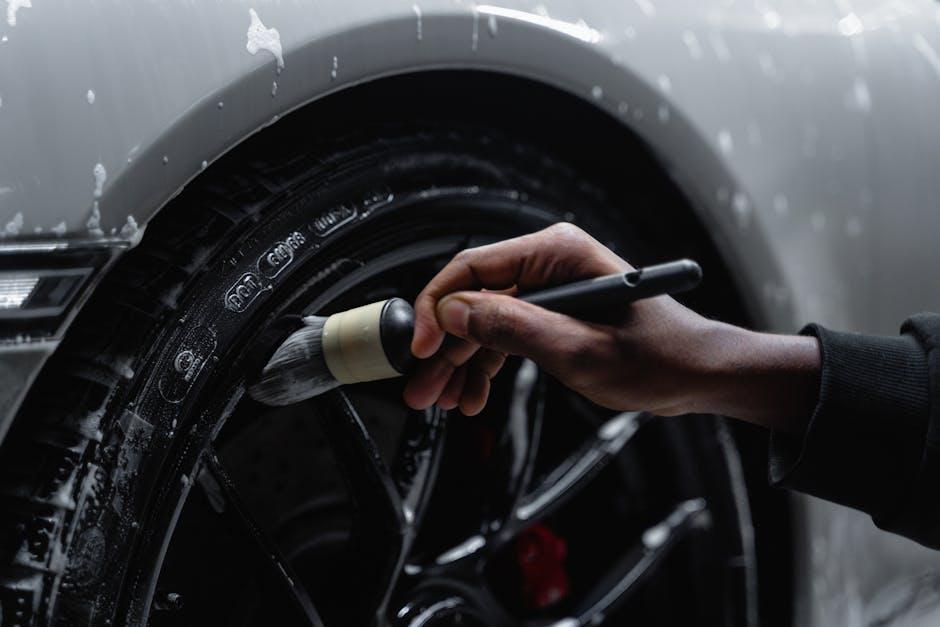There’s something undeniably satisfying about a set of gleaming tires — they instantly elevate the look of any vehicle, adding a polished, showroom-ready touch. But achieving that perfect shine is only half the story. The real challenge lies in maintaining it, keeping your tires looking fresh and vibrant mile after mile. In this article, we’ll explore the best practices for cleaning and caring for your tire shine, ensuring your wheels stay lustrous without the streaks, grime, or premature fading that can dull their appeal. Whether you’re a seasoned car enthusiast or a casual weekend detailer, mastering these simple steps will help you preserve that head-turning glow with ease.
Table of Contents
- Choosing the Right Tire Shine Products for Your Vehicle
- Preparing Tires for Effective Cleaning and Application
- Step-by-Step Guide to Applying Tire Shine for a Lasting Gloss
- Tips for Maintaining Tire Shine in Different Weather Conditions
- Common Mistakes to Avoid When Using Tire Shine
- Eco-Friendly Alternatives for Tire Care and Shine Maintenance
- Q&A
- In Summary

Choosing the Right Tire Shine Products for Your Vehicle
Selecting the perfect tire shine product involves balancing performance with the specific needs of your vehicle’s tires. Matte finishes work well for a subtle look that highlights tire texture, while high-gloss formulas create a mirror-like shine ideal for show cars. Consider water-based options if you favor environment-friendly and non-greasy applications, or solvent-based products for longer-lasting protection against road grime and UV damage. Checking ingredient lists for conditioners like silicone or natural oils can help maintain tire flexibility and prevent cracking, ensuring your tires not only look great but stay durable over time.
When evaluating products, the type of application method is equally crucial. Spray-on formulas allow for quick, even coverage without excess handling, while gel or foam varieties provide more control for precision and building layers of shine gradually. Be mindful of compatibility with wheel finishes to avoid unwanted residue or staining. Below is a quick comparison to guide your choice:
| Product Type | Best For | Durability | Application |
|---|---|---|---|
| Water-Based Spray | Eco-conscious drivers | Moderate | Quick, even spray |
| Solvent-Based Gel | Show cars, long-lasting shine | High | Controlled, layered application |
| Foam | Easy to handle, precise areas | Moderate to High | Soft foam applicator |

Preparing Tires for Effective Cleaning and Application
Before diving into the cleaning process, start by giving your tires a thorough inspection. Remove any loose debris such as dirt, grass, or small stones using a stiff brush or air compressor. This preliminary step prevents grime from embedding deeper into the rubber during cleaning. For stubborn mud or grease, a gentle rinse with water helps loosen the buildup, making the next steps more effective. Remember: dry tires lead to uneven application of shine products, so keeping them slightly damp will maximize product adhesion.
Next, prepare your cleaning station with all necessary materials within reach to streamline the process. A high-quality tire cleaner, soft-bristled brush, microfiber cloths, and tire dressing should be ready to go. Here’s a quick checklist to keep handy:
- Stiff-bristled brush for initial debris removal
- Foaming tire cleaner designed for rubber surfaces
- Microfiber towels for drying and buffing
- Tire dressing or shine product suited to your preference
| Tool | Purpose | Tip |
|---|---|---|
| Stiff Brush | Remove loose dirt | Use gentle circular motions |
| Tire Cleaner | Break down grime | Opt for pH-balanced formulas |
| Microfiber Cloth | Drying and buffing | Replace when contaminated |
| Tire Dressing | Shine and protect | Apply evenly in shade |

Step-by-Step Guide to Applying Tire Shine for a Lasting Gloss
Start by thoroughly cleaning your tires to remove dirt and grime, ensuring the shine adheres properly. Use a dedicated tire cleaner along with a stiff brush to scrub away residues. Once clean, rinse with water and dry completely using a microfiber cloth or allow the tires to air dry. Avoid applying tire shine on hot or direct sunlight-exposed surfaces to prevent uneven absorption.
When ready, apply the product evenly to the tire sidewalls with a foam applicator or a dedicated tire brush. Use gentle, circular motions to cover every inch, ensuring a smooth coat without over-saturating. For an extra level of protection and gloss, apply a second thin layer after the first one has dried. To maintain that fresh look, repeat the process every two weeks or after washing your car.
- Clean tires thoroughly before application
- Use foam applicator or tire brush for even coverage
- Avoid direct sunlight during application
- Apply multiple thin coats rather than one thick coat
- Reapply every 2 weeks for lasting results
| Step | Task | Tip |
|---|---|---|
| 1 | Clean Tires | Use dedicated tire cleaner |
| 2 | Dry Completely | Use microfiber cloth or air dry |
| 3 | Apply Tire Shine | Use foam applicator for even spread |
| 4 | Optional Second Coat | Apply after first coat dries |
| 5 | Regular Maintenance | Reapply every 2 weeks |

Tips for Maintaining Tire Shine in Different Weather Conditions
Maintaining that glossy tire shine year-round requires a little adaptation to the elements. In humid or rainy climates, frequent drying is key—water can dull the finish quickly. After each wash or rain, use a clean microfiber cloth to gently pat your tires dry, preventing water spots. For sunny weather, opt for tire dressings with UV protection to fend off cracking and fading caused by harsh rays. A light application every couple of weeks can keep both the shine and tire integrity intact, without the risk of a greasy finish that attracts dirt.
Cold and snowy conditions present their own challenges. Salt and road grime are notorious for dulling tire shine, so rinse your tires promptly and regularly during winter. Consider using silicone-based tire dressings, which tend to repel water and resist wash-off better than water-based varieties in icy weather. The chart below offers a quick guide to weather-specific tire care tips:
| Weather | Key Tip | Recommended Product |
|---|---|---|
| Sun & Heat | Apply UV-protected dressing bi-weekly | Silicone-based dressing |
| Rain & Humidity | Dry tires after washing or rain | Water-based dressing |
| Cold & Snow | Rinse away salt promptly | Silicone or polymer-based dressing |

Common Mistakes to Avoid When Using Tire Shine
Many enthusiasts fall into the trap of applying tire shine products on dirty tires. This mistake not only lessens the product’s effectiveness but can also cause uneven gloss and attract more dirt. Always make sure your tires are thoroughly cleaned and dried before application. Another common pitfall is using too much tire shine. Excess product tends to sling onto sidewalls and even the vehicle’s paint, creating an unsightly mess that’s tough to clean. A light, even coat generally achieves the best, long-lasting results.
Using the wrong type of tire shine could also damage your tires or reduce longevity. For instance, solvent-based products might create a brittle surface, while water-based formulas provide a more natural, supple finish. Additionally, avoid applying tire shine in direct sunlight or on hot tires, as this can cause the product to bake on, leading to uneven patches and streaks. Keep these tips in mind to protect both the beauty and integrity of your tires.
- Always clean and dry tires first.
- Apply tire shine sparingly and evenly.
- Choose the appropriate formula for your tire type.
- Avoid application under direct sunlight or on hot tires.
- Reapply as recommended for the best results.

Eco-Friendly Alternatives for Tire Care and Shine Maintenance
Embracing sustainable options for tire care not only benefits your vehicle’s look but also minimizes environmental impact. Opt for natural tire dressings made from biodegradable ingredients like coconut oil and beeswax. These products enhance tire shine without the toxic chemicals found in traditional silicone-based dressings. Additionally, using a mild mixture of water and vinegar to clean your tires removes dirt effectively while avoiding harsh pollutants. For application, a soft brush or microfiber cloth ensures gentle cleaning and optimal absorption of eco-friendly shine solutions.
Here are some practical alternatives for maintaining your tire’s vibrant appearance while staying green:
- DIY tire shine: Mix equal parts of water and olive oil for a natural glossy finish.
- Plant-based cleaners: Utilize castile soap diluted in water to gently wash tires without chemical residues.
- Reusable cleaning tools: Choose microfiber towels or brushes made from sustainable materials for long-lasting use.
| Eco-Friendly Product | Key Ingredient | Benefit |
|---|---|---|
| Coconut Shine Spray | Coconut Oil | Moisturizes and adds a natural gleam |
| Beeswax Tire Balm | Beeswax | Protects against cracking and UV rays |
| Castile Soap Cleaner | Olive Oil Soap | Gentle but effective dirt removal |
Q&A
Q&A: How to Clean and Maintain Tire Shine
Q1: Why is tire shine important for vehicle maintenance?
A: Tire shine does more than just boost your car’s aesthetic—it protects your tires from harmful UV rays, prevents cracking, and repels dirt and grime. Keeping your tires looking fresh helps maintain their longevity and enhances the overall appeal of your vehicle.
Q2: What types of tire shine products are available?
A: Tire shine products come in several forms, including sprays, gels, foams, and wipes. Each has its own application method and finish—some offer a wet, glossy look while others provide a more natural matte sheen. Choosing the right type depends on your preference and tire condition.
Q3: How should I prepare my tires before applying tire shine?
A: Before applying any tire shine, it’s essential to clean the tires thoroughly. Use a tire cleaner or mild soap with water to remove dirt, brake dust, and old tire dressings. Scrub with a stiff brush, rinse well, and allow the tires to dry completely. Applying tire shine on clean, dry tires ensures better adherence and longer-lasting results.
Q4: How do I apply tire shine correctly?
A: For sprays and liquids, apply a small amount onto a foam applicator or directly on the tire sidewall, then spread evenly. Gels require less product—dab and smooth onto the tire surface. Avoid applying tire shine on the tread to prevent slippery conditions. Always follow product instructions for best results.
Q5: How often should I reapply tire shine?
A: The frequency depends on driving conditions and product type, but generally, reapplying every 1 to 2 weeks keeps tires looking fresh. If you frequently drive in wet or dusty environments, you may need to touch up more often.
Q6: Are there any precautions to take when using tire shine?
A: Yes—avoid getting tire shine on your car’s paint or rims, as some formulations can attract dust or cause damage. Also, be mindful of slippery surfaces after application; let the product dry fully before driving. Finally, store tire shine products in a cool, dry place to maintain their effectiveness.
Q7: Can tire shine damage tires over time?
A: Generally, quality tire shine products designed for automotive use are safe. However, some silicone-based or petroleum-based products can cause premature cracking if overused. Opt for water-based or natural formulations and use them in moderation to help preserve tire integrity.
Q8: What’s the best way to maintain a natural tire shine without chemicals?
A: For a natural approach, regularly clean tires with soapy water and buff dry. Some detailers use diluted apple cider vinegar or mild conditioning oils to restore shine gently. While these methods might not produce an intense gloss, they reduce the risk of long-term tire damage.
Q9: Can I use homemade tire shine recipes?
A: Homemade recipes, like mixes of water and baby oil, might give temporary shine but generally lack protective benefits and can attract dirt. Commercial products are formulated with polymers that create a barrier against environmental damage, so for best results, use them over DIY alternatives.
Q10: How does proper tire maintenance impact vehicle safety?
A: Maintaining clean, well-protected tires prevents cracking and deterioration, which can lead to blowouts or poor traction. While tire shine mainly improves appearance and protection, regular inspections and pressure checks are vital for safe driving. Together, they keep your vehicle looking good and running safely.
In Summary
Keeping your tires gleaming doesn’t have to be a mystery or a chore. With the right cleaning routine and a bit of regular maintenance, you can ensure that tire shine not only dazzles but lasts longer, enhancing the overall look of your vehicle. Remember, the secret lies in gentle care, smart products, and consistent attention. So next time your tires catch someone’s eye, you’ll know it’s not just the shine—it’s the pride you take in the journey.

